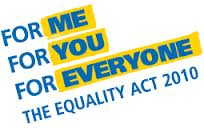Disability and The Equality Act 2010.
From 1 October 2010, the Equality Act replaced most of the Disability Discrimination Act (DDA). However, the Disability Equality Duty in the DDA continues to apply. Find out about the protection and legal rights the Equality Act provides for disabled people.
Equality Act 2010
The Equality Act 2010 aims to protect disabled people and prevent disability discrimination. It provides legal rights for disabled people in the areas of:
•employment
•education
•access to goods, services and facilities including larger private clubs and land based transport services
•buying and renting land or property
•functions of public bodies, for example the issuing of licences
The Equality Act also provides rights for people not to be directly discriminated against or harassed because they have an association with a disabled person. This can apply to a carer or parent of a disabled person. In addition, people must not be directly discriminated against or harassed because they are wrongly perceived to be disabled.
More information about the Equality Act, and how you can obtain copies of the Act, can be found on the Government Equalities Office website.
The definition of ‘disability’ under the Equality Act 2010
In the Act, a person has a disability if:
•they have a physical or mental impairment
•the impairment has a substantial and long-term adverse effect on their ability to perform normal day-to-day activities
For the purposes of the Act, these words have the following meanings:
•'substantial' means more than minor or trivial
•'long-term' means that the effect of the impairment has lasted or is likely to last for at least twelve months (there are special rules covering recurring or fluctuating conditions)
•'normal day-to-day activities' include everyday things like eating, washing, walking and going shopping
People who have had a disability in the past that meets this definition are also protected by the Act.
Progressive conditions considered to be a disability
There are additional provisions relating to people with progressive conditions. People with HIV, cancer or multiple sclerosis are protected by the Act from the point of diagnosis. People with some visual impairments are automatically deemed to be disabled.
Conditions that are specifically excluded
Some conditions are specifically excluded from being covered by the disability definition, such as a tendency to set fires or addictions to non–prescribed substances.
Where to get more guidance on the definition of disability
The government has published statutory guidance, to assist adjudicating bodies like courts and tribunals in deciding whether a person is a disabled person. This guidance is called “Guidance on matters to be taken into account in determining questions relating to the definition of disability”.
It was published for the purposes of the Disability Discrimination Act, but continues to apply under the Equality Act 2010, where appropriate. New guidance is expected to be published in spring 2011.
You can read the current guidance on the Equality and Human Rights Commission’s (EHRC) website. (found on Links Page)


